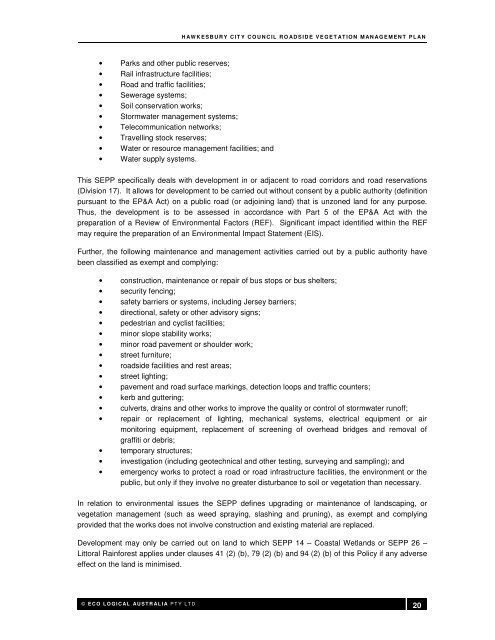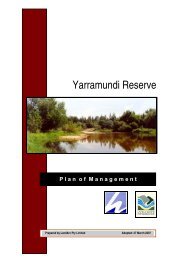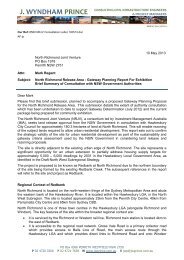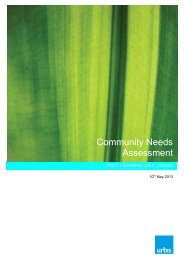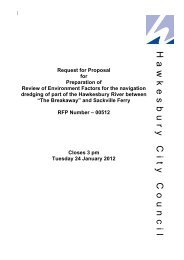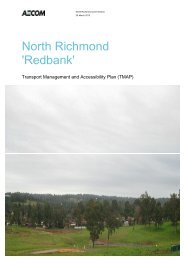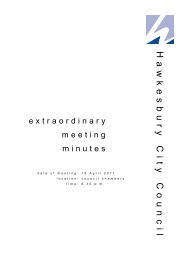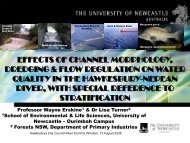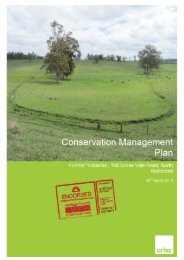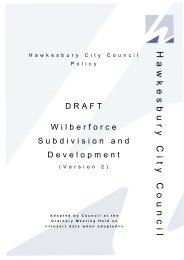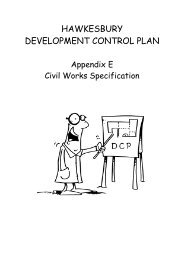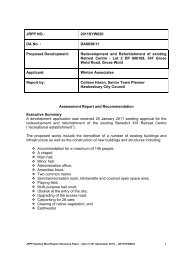Attachment 1 to Item 53 - Roadside Vegetation Management Plan
Attachment 1 to Item 53 - Roadside Vegetation Management Plan
Attachment 1 to Item 53 - Roadside Vegetation Management Plan
You also want an ePaper? Increase the reach of your titles
YUMPU automatically turns print PDFs into web optimized ePapers that Google loves.
H AW K E S B U R Y C IT Y C O U N C IL R O AD S ID E V E G E T AT IO N M AN AG E M E N T P L AN<br />
• Parks and other public reserves;<br />
• Rail infrastructure facilities;<br />
• Road and traffic facilities;<br />
• Sewerage systems;<br />
• Soil conservation works;<br />
• S<strong>to</strong>rmwater management systems;<br />
• Telecommunication networks;<br />
• Travelling s<strong>to</strong>ck reserves;<br />
• Water or resource management facilities; and<br />
• Water supply systems.<br />
This SEPP specifically deals with development in or adjacent <strong>to</strong> road corridors and road reservations<br />
(Division 17). It allows for development <strong>to</strong> be carried out without consent by a public authority (definition<br />
pursuant <strong>to</strong> the EP&A Act) on a public road (or adjoining land) that is unzoned land for any purpose.<br />
Thus, the development is <strong>to</strong> be assessed in accordance with Part 5 of the EP&A Act with the<br />
preparation of a Review of Environmental Fac<strong>to</strong>rs (REF). Significant impact identified within the REF<br />
may require the preparation of an Environmental Impact Statement (EIS).<br />
Further, the following maintenance and management activities carried out by a public authority have<br />
been classified as exempt and complying:<br />
• construction, maintenance or repair of bus s<strong>to</strong>ps or bus shelters;<br />
• security fencing;<br />
• safety barriers or systems, including Jersey barriers;<br />
• directional, safety or other advisory signs;<br />
• pedestrian and cyclist facilities;<br />
• minor slope stability works;<br />
• minor road pavement or shoulder work;<br />
• street furniture;<br />
• roadside facilities and rest areas;<br />
• street lighting;<br />
• pavement and road surface markings, detection loops and traffic counters;<br />
• kerb and guttering;<br />
• culverts, drains and other works <strong>to</strong> improve the quality or control of s<strong>to</strong>rmwater runoff;<br />
• repair or replacement of lighting, mechanical systems, electrical equipment or air<br />
moni<strong>to</strong>ring equipment, replacement of screening of overhead bridges and removal of<br />
graffiti or debris;<br />
• temporary structures;<br />
• investigation (including geotechnical and other testing, surveying and sampling); and<br />
• emergency works <strong>to</strong> protect a road or road infrastructure facilities, the environment or the<br />
public, but only if they involve no greater disturbance <strong>to</strong> soil or vegetation than necessary.<br />
In relation <strong>to</strong> environmental issues the SEPP defines upgrading or maintenance of landscaping, or<br />
vegetation management (such as weed spraying, slashing and pruning), as exempt and complying<br />
provided that the works does not involve construction and existing material are replaced.<br />
Development may only be carried out on land <strong>to</strong> which SEPP 14 – Coastal Wetlands or SEPP 26 –<br />
Lit<strong>to</strong>ral Rainforest applies under clauses 41 (2) (b), 79 (2) (b) and 94 (2) (b) of this Policy if any adverse<br />
effect on the land is minimised.<br />
© E C O L O G I C AL AU S T R AL I A P T Y L T D<br />
20


